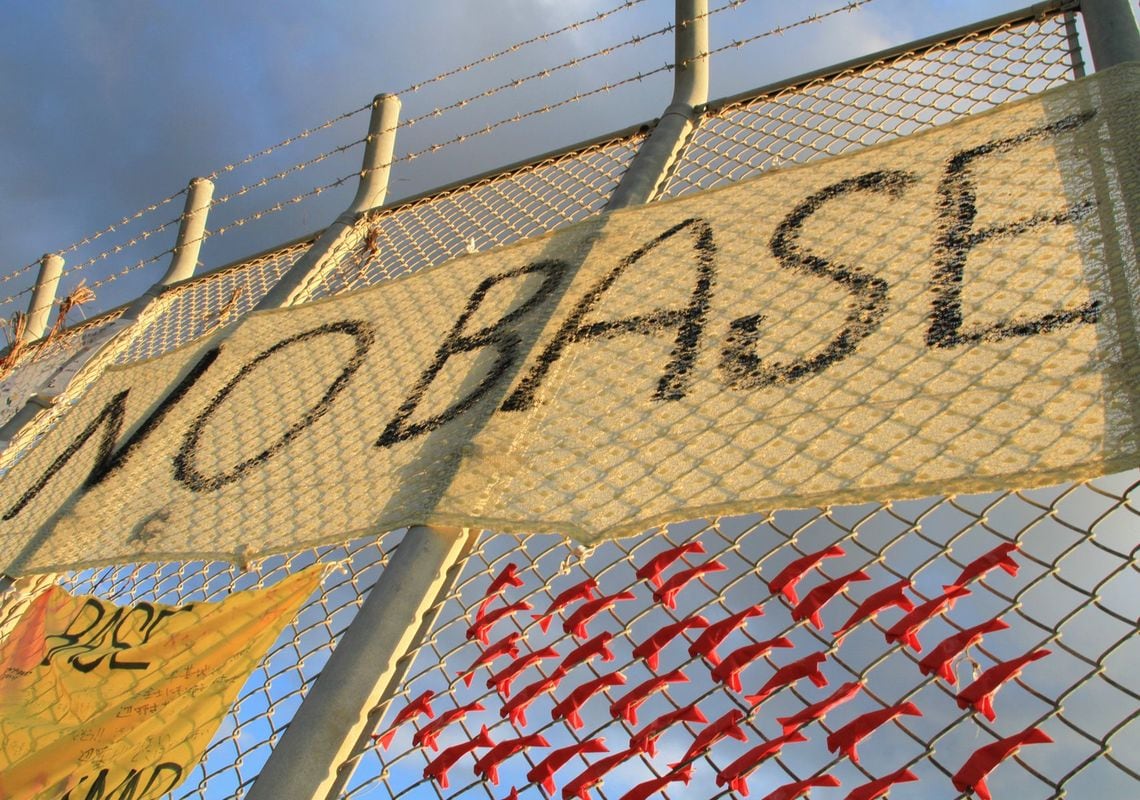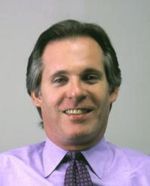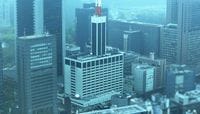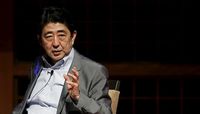
Prime Minister Shinzo Abe continues to struggle with widespread public opposition to his push to overhaul Japan’s pacifist, “self-defense only” security policy. But that is not Abe’s only headache on defense issues.
Okinawa governor Takeshi Onaga is escalating his fierce resistance to a US-Japan plan to build a new US Marine facility in Japan’s southern-most, and poorest, prefecture.
Onaga was swept into office last November on a wave of anger over the 2013 decision by his predecessor, Hirokazu Nakaima, to approve a massive landfill project necessary for construction of the new base, in the Henoko district of Nago City. The new base is supposed to replace the existing Marine Air Station Futenma, which the US and Japan agreed to close almost twenty years ago.
Shortly after taking office in December of last year, Onaga pledged to look for legal flaws in Nakaima’s approval of the landfill project, as a means to cancel the permit. He subsequently established a 3-person panel to investigate Nakaima’s decision-making process. The panel initially said it would issue its report at the end of June, but the release will likely not take place until the end of this month.
Meanwhile, in the first week of June, Onaga and a large delegation of Okinawa Prefectural Assembly members brought their case to Washington, hoping to meet influential Americans who might press the Obama administration and Congress for a change in policy. The Obama administration only made available two mid-level officials from the State and Defense departments. The State Department issued a statement reiterating US policy that there was “no viable alternative” to the Henoko project.
Overall, Onaga demonstrated an unusually pugnacious, if polite, willingness to speak directly to US officials. He denied at a June 3 press conference that the trip had been a failure, saying he never expected the US government to easily change its view. Onaga has established an official prefectural office in Washington to continue lobbying Congress and the administration.
Toyo Keizai talked to Onaga about Henoko issue.
The dignity of Okinawan is not defended
――The conflict between Okinawa and the central government has become so intense that it raises the question: do you think of yourself primarily as Okinawan or Japanese?
Fundamentally, I believe I am Japanese. However, sometimes, when I consider our historical development and the status quo, I have some doubts about this. But, fundamentally, I am Japanese.
――Do you harbor any desire for Okinawa to break away from Japan?
I have no intention of trying to achieve independence of Okinawa from Japan. However, looking at the status quo, it is clear that Okinawa bears an excessive burden of the US military base presence in Japan. Okinawa accounts for only 0.6 percent of Japan’s national territory, but is host to 73.8 percent of facilities used by the US in Japan.
Seventy years ago, at the time of the grand battle in Okinawa, more than 200,000 people died, including at least 100,000 Okinawan people.
At the San Francisco peace treaty conference, Okinawa was separated from Japan. That means when I was growing up, I was neither a Japanese citizen nor an American citizen. This fact remains in the back of my mind. But I feel responsible to play my role as a Japanese person.
Meanwhile, the issue of US military bases in Okinawa remains. The central government continues to impose the heavy burden on Okinawa to host such a big portion of US military facilities. It is unfair. The dignity and human rights of Okinawans have not been defended.
In last year’s elections, all four candidates for the national Diet endorsed by the Liberal Democrats (LDP) were defeated. And the LDP candidates for mayor of Nago City, for the Nago assembly, and for the governor of Okinawa prefecture were all rejected by voters. Candidates who opposed the Henoko base construction plan were elected. But the central government ignored these results.
It is not Okinawa that tries to distinguish itself from the rest of Japan. It is the central government that treats Okinawa as if it were not part of Japan.
Complicated relationship with Tokyo
――From the Okinawa point of view, which is more complicated: relations with Tokyo, or relations with the US Marines?
Both are difficult. But if I have to identify the bigger problem, I would say it is the central government in Tokyo. It is the responsibility of the central government to protect the Japanese people.
I understand that the US military suffered many casualties on Okinawa toward the end of the Pacific War, and established bases on Okinawa in preparation of possible future conflicts. And I understand that both Japan and the US are democratic nations working together to deal with common concerns, such as the rise of China. But I think the US military has to pay more attention to the burden imposed on Okinawa by the heavy US base presence. To not do so could pose a risk to the whole bilateral security arrangement.
――Despite the conflict over the Henoko project, do you remain a supporter of the US-Japan alliance?
I have served as a politician for over 30 years, and I have consistently supported the US-Japan security arrangement. However, the burden of hosting so much of the US military presence is simply excessive.
With regard to the Futenma air station, our land was expropriated by the US forces, and our people were forced into concentration camp conditions.
With regard to other US bases, the US used bulldozers to destroy our houses, expropriate our land, and build new bases. The people of Okinawa have never voluntarily offered our land for base construction. And now, the US acknowledges that the Futenma air station is the most dangerous airport in the world. But the US says that if Okinawans oppose construction of the new Henoko facility, it is Okinawa that must come up with an alternative plan.
The Japanese government often makes similar comments, and asks us: “Are you Okinawans really thinking about the security of Japan?” This is remarkable. Okinawa was separated from Japan by the San Francisco Treaty, and hosted most of the US bases, which in turn allowed Japan proper to focus on high-level economic development. Okinawa has suffered a lot, which is a situation that cannot endure.
I fully accept the US-Japan security arrangement, assuming it is fair. The US-Japan security arrangement has to be dignified, and protect freedom, democracy, and human rights. This is very helpful to Asia, and the rest of the world. But, at this point, the security arrangement does not extend these values to the Okinawan people. Under these circumstances, the alliance is groundless.
――The fuel tankers that used to be based at Futenma have already moved to Iwakuni. So the issue is: where to base the 24 Osprey the Marines want to place in Okinawa. Couldn’t the Osprey be placed inside Camp Schwab, or inside the Kadena air base? In other words, why do the Marines need a new runway at Henoko?
It is not clear to me why the Marines want a new runway at Henoko. But my suspicion is that in 30-40 years, Japan’s Self-Defense Forces will utilize the new facility.
The former defense minister, Satoshi Morimoto, has written that the Henoko facility is designed to eventually host more than 100 Osprey. Morimoto wrote in his last book that 12 Osprey would be deployed to Okinawa in 2012, and another 12 in 2013. At the time, the MOD denied any knowledge of such a plan. But it turned out to be true. So the real question is: how many Osprey do the Marines plan to deploy in Okinawa? We don’t know.
Talking with the US and Tokyo
――How is your personal relationship with Prime Minister Abe and Chief Cabinet Secretary Suga?
Looking back over his personal history, Suga has tried to cozy up with people in power so as to promote himself. That is at the root of Suga’s relationship with Abe.
――Prime Minister Abe on occasion has questioned the validity of the San Francisco Peace Treaty.
Two years ago, he sponsored a ceremony celebrating the signing of the treaty, as it marked the return of sovereignty to Japan. But Okinawans were shocked, because Okinawa was separated from the rest of Japan, and kept under US occupation. Abe was not thinking about Okinawa.
This indicated to me that Japan’s sense of responsibility to other countries is weak. In this sense, I think Abe has inherited the ideas of his grandfather, Kishi Nobusuke. Abe has often said that he wants Japan to emerge from under the postwar regime, and restore pride in Japan. But I wonder whether Abe includes Okinawa in his thinking, because with regards to Okinawa, Abe is desperately defending the postwar regime.
――With regards to Henoko, have you already made your decision to reverse the landfill approval of former governor Nakaima that allows construction at Henoko to proceed?
Several years ago I served as campaign manager for then-governor Nakaima. I spent many hours with him, and we agreed on the campaign pledge to move a Futenma replacement facility outside of Okinawa.
But later, without any consultation with me, he approved the landfill application, which was very damaging to the pride of Okinawans. People on the mainland said that Nakaima made his decision in exchange for economic aid from Tokyo. This was very hurtful. I decided to run for governor to help restore the damaged pride of Okinawans. I have a very strong determination to oppose the Henoko project, perhaps by reversing Nakaima’s decision.
But I am also aware of the US-Japan security situation, so my administration is trying to engage in talks with the US and Tokyo to find a solution.
If Japan and the US try to push ahead with the Henoko project, which they justify in part as a response to the rise of China, then the image of the US will be very damaged. That is why I think the new facility will actually not be built.




